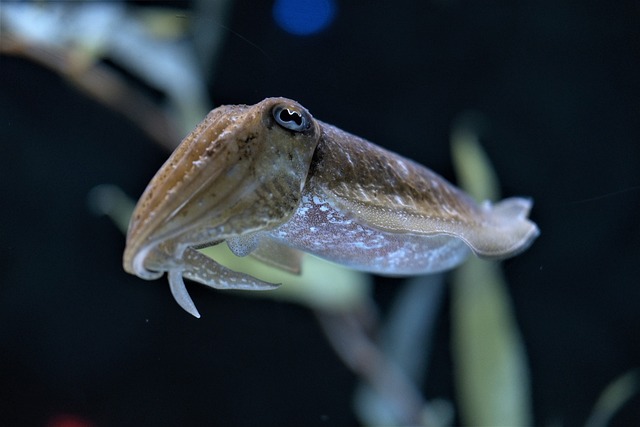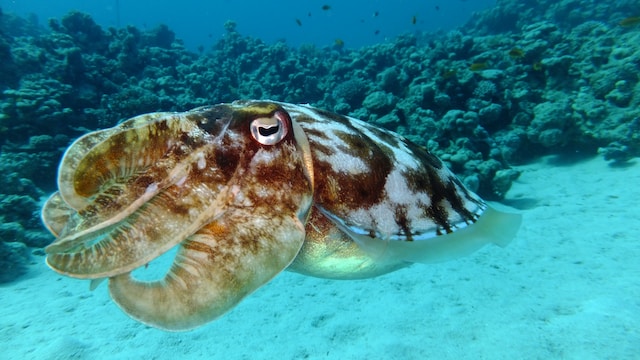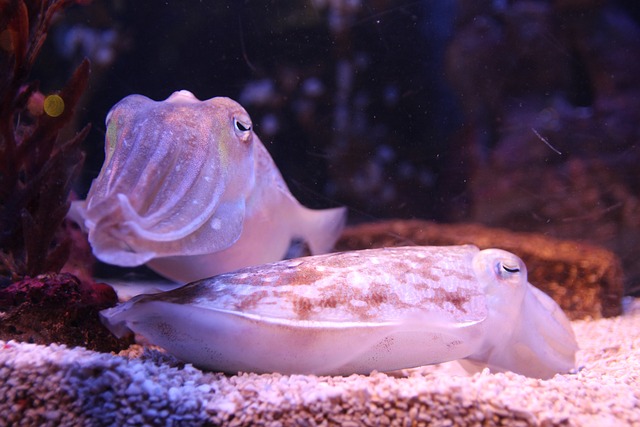Cuttlefish and squid are both cephalopods, but they differ in body shape (cuttlefish are wider), tentacle structure, and internal shell presence (cuttlefish have a buoyancy-regulating cuttlebone). Squid are more streamlined with longer bodies and have a chitinous pen instead of a cuttlebone.
TL;DR Cuttlefish Vs. Squid
Cuttlefish are known for their unique internal shell or “cuttlebone,” which helps control buoyancy and provides support. They have a soft body with a broad fin running along the entire length of their mantle.
Squid have a streamlined body with a long mantle and ten arms equipped with powerful suction cups. They lack an internal shell like cuttlefish but possess a slender pen-like structure instead. Squid are incredibly fast swimmers and use their agility to catch prey.
What are cuttlefish?

Cuttlefish belong to the same family as squids and octopuses, known as cephalopods. These marine mollusks can be found in oceans all around the world, inhabiting both shallow coastal waters and deeper offshore regions.
One of the most distinctive features of cuttlefish is their unique internal shell called a cuttlebone. This bone serves various purposes – it helps control buoyancy by regulating gas inside its chambers, provides support for the soft body, and even acts as a calcium-rich snack for other marine animals.
With their large eyes and amazing cognitive abilities, cuttlefish are considered to be among the most intelligent invertebrates. They have an incredible ability to camouflage themselves by rapidly changing colors and patterns on their skin using specialized cells called chromatophores.
These masterful masters of disguise also use their tentacles to capture prey – mainly small fish and crustaceans. Their feeding strategy involves extending two long feeding tentacles from which they shoot out at lightning speed to snatch up unsuspecting victims.
What are squid?

Squid belong to the cephalopod family, just like their close relatives, cuttlefish and octopus. With their sleek bodies, tentacles, and ability to change colors in a flash, squid are truly captivating.
These marine mollusks can be found in oceans all around the world. Known for their unique hunting tactics and agility underwater, squid use their powerful jet propulsion technique to swiftly move through the water. Their elongated bodies allow them to quickly change direction when pursuing prey or avoiding predators.
One of the most distinct features of squid is their large eyes. In fact, some species have eyes that are as big as basketballs! These enormous eyes help them navigate through dimly lit depths where they often dwell.
Squid possess ten arms altogether – eight shorter ones called arms and two longer ones known as tentacles. Equipped with suction cups lined with tiny teeth-like structures called suckers, these appendages come in handy when catching prey or defending themselves against potential threats.
As voracious predators, squid feed on various small fish and crustaceans using a combination of stealth and speed. They also employ an arsenal of defensive techniques such as releasing ink clouds to confuse attackers or even changing color patterns on their skin for camouflage purposes.
Cuttlefish Vs. Squid – Key differences
| Aspect | Cuttlefish | Squid |
|---|---|---|
| Body Shape | Wider, with a broad, oval body | Streamlined, elongated body |
| Tentacle Structure | Shorter arms, longer feeding tentacles | Longer arms, shorter feeding tentacles |
| Internal Shell | Cuttlebone present, used for buoyancy control | Chitinous pen present, provides structure |
| Habitat | Often found in shallow coastal waters | Found in a variety of ocean depths |
| Camouflage Abilities | Exceptional camouflage abilities, can rapidly change skin color and texture | Capable of camouflage but typically not as versatile |
| Size | Generally smaller in size | Tend to be larger in size |
| Lifespan | Shorter lifespan, typically 1-2 years | Longer lifespan, often 1-3 years |
| Unique Features | Unique W-shaped pupils, can swim in any direction | Typically have round pupils, swim in a straight line |
How to cook cuttlefish and squid
One popular way to cook these cephalopods is by grilling them. Marinate the cuttlefish or squid in a mixture of olive oil, lemon juice, garlic, and your choice of herbs for about 30 minutes. Then simply grill them over medium-high heat until they turn opaque and slightly charred. This method imparts a smoky flavor that pairs perfectly with the natural sweetness of the seafood.
Frying is another tasty option. Coat thin slices of cuttlefish or squid in seasoned flour or breadcrumbs before deep-frying until golden brown and crispy. Serve them as an appetizer with a squeeze of lemon juice on top for added tanginess.
If you prefer something more comforting, consider adding these mollusks to a pasta dish. Sauté some minced garlic in olive oil before tossing in thinly sliced calamari rings or diced cuttlefish pieces. Cook until they become tender and then mix with cooked pasta noodles, fresh herbs like parsley or basil, grated Parmesan cheese, and a drizzle of extra virgin olive oil.
Of course, there are countless other ways to prepare these versatile creatures – from stir-fries to stews – so feel free to get creative! The key is not to overcook them as they can quickly become rubbery if left too long on heat.
Image Credits
Featured Image By – manseok Kim from Pixabay
Image 1 By – Naveen Manohar from Pixabay
Image 2 By – Peter Boshra on Unsplash








